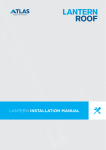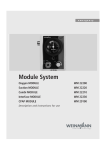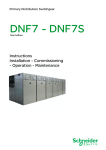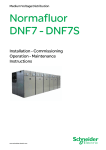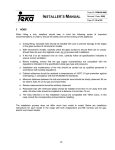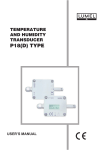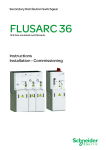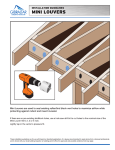Download SOLAR SOLC201 – On roof kit Installation Manual
Transcript
SOLAR SOLC201 – On roof kit Installation Manual Page 1 of 32 R01450-2 12/11 SOLC201 – On roof kit installation manual SOLAR 0 Overall view Figure 1: Overall view of installation method Page 2 of 32 R01450-2 12/11 SOLC201 – On roof kit installation manual SOLAR 1 Contents 0 OVERALL VIEW 2 1 CONTENTS 3 2 BEFORE YOU START 4 2.1 2.2 2.3 2.4 2.5 2.6 2.7 GENERAL COMPETENCE HEALTH AND SAFETY RISK ASSESSMENT TOOLS REQUIRED EARTHING AND LIGHTNING PROTECTION PIPE WORK 4 4 4 5 5 5 5 3 SCOPE OF DELIVERY 6 4 PRODUCT FEATURES AND DESCRIPTIONS 7 5 COLLECTOR CONNECTIONS 8 5.1 SINGLE COLLECTOR VERTICAL CONNECTION 5.2 MULTIPLE COLLECTOR VERTICAL CONNECTION 5.3 SINGLE COLLECTOR HORIZONTAL CONNECTION 8 9 11 6 INSTALLATION 13 7 OPERATION 25 8 MAINTENANCE 25 9 DECOMMISSIONING 25 10 TECHNICAL DATA 25 Page 3 of 32 R01450-2 12/11 SOLC201 – On roof kit installation manual SOLAR 2 2.1 Before you start General Thank you for choosing a Dimplex product. We ensure you that every effort has been made at the design, manufacture and delivery stages to produce a product with superior quality. We will provide you with the best possible support throughout the product’s lifespan. As part of ongoing product development and improvement Dimplex reserves the right to undertake changes to the product without prior notice. Great care has been taken to ensure this manual was correct at the time of print. Should you however discover any issues with the information contained therein please do not hesitate to contact your vendor. We strongly recommend reading the whole contents of this manual before commencing the work. 2.2 Competence Dimplex products have been designed and manufactured to the current relevant standards and under stringent quality control. It is therefore imperative that the product is only installed by a: - trained and - competent person as defined in the relevant regulations. Dimplex does not accept any liability for damage done to persons or property resulting from undue handling and usage of this product. All regulations current at the time of installation are to be considered alongside the content of this manual as they form the code of best practice. The warranty of this product is linked to the ability to prove that the product was installed, commissioned and maintained: - by a competent person. - in accordance with Dimplex instructions and the current relevant regulations and legislation. - the product being registered with Dimplex at the time of installation using the form in the Dimplex On Site Guide. - records showing the date of maintenance in accordance with the maintenance schedule as detailed in the On Site Guide. 2.3 Health and Safety The installation of this product is subject to the Health and Safety at Work Act. It is your responsibility to ensure that the transport, storage, installation and operation of the product are carried out in a safe manner. Dimplex will not accept any liability due to damage caused to people or property resulting from negligence or not adhering to the relevant Health and Safety practices. Page 4 of 32 R01450-2 12/11 SOLC201 – On roof kit installation manual SOLAR 2.4 Risk assessment The compilation of a risk assessment is strongly recommended before installing the product. The following areas require particular consideration in addition to the information required by the Health and Safety at Work Act. - scalding: where appropriate or required by law a thermostatic mixing valve is to be fitted to the hot water outlet of the cylinder. - explosion: the unit is fully equipped with all relevant safety equipment to comply with current regulations. The correct design and function has been verified by independent third party testing. The correct application thereof is the responsibility of the competent installer. - water borne organisms (i.e. Legionella): if applicable a risk assessment should be carried out following the recommendations outlined in the Approved Code of Practice L8. - the user preference must be considered when commissioning the system, in particular when adjusting the solar and auxiliary system temperature and timer settings. 2.5 Tools required It is recommended that the below list of tools be used when installing the Dimplex solar collector. - 2.6 Two people required to complete this installation Cordless drill with 6mm wood bit, 13mm socket wrench and 14mm masonry bit Measuring tape Spanners, 13/17/19/20/22/30/32mm 6mm Allen Key Angle Grinder With Stone Disc Adjustable Pliers or Pipe Wrench Flat Head Screw Driver Earthing and lightning protection If a lightning arrester is available, the collector frame should be connected to it. This may be preformed using the collector frame, because the slot for mounting on the reverse side of the collector is ideally suited for fixing a thick cable. If no arrester is available, the potential equalization is carried out using a connection of a cable at the tube(s) which are led in the building. Please consult local regulations to ensure adherence. 2.7 Pipe Work The pipe work from the collector to the pump unit and from the pump unit to the cylinder is to be all metal. The joints have to be high temperature resistant (compression, high temperature flat seal or high temperature press fitting). For more information please see Technical Manual – Complete guide to Dimplex Solar, R00270. Page 5 of 32 R01450-2 12/11 SOLC201 – On roof kit installation manual SOLAR 3 Scope of delivery Please check the contents and the condition of your delivery before signing the delivery documentation against the content shown in Table 1 below and mark as appropriate. Contact your supplier immediately for any missing or damaged parts. Claims for missing or damaged parts after signing for the delivery documentation will not be accepted. Table 1: Contents for basic and extension on roof kits Page 6 of 32 R01450-2 12/11 SOLC201 – On roof kit installation manual SOLAR 4 Product features and descriptions The Dimplex on roof mounting kit offers a simple and fast solution for fixing solar collectors to the roof of a building. The kit basically consists of roof anchors which are secured to the rafters of the roof. A rail is then secured to these roof anchors and the collector fixed onto the rail. Various roof anchors are available to cater for most roof coverings. One kit may be used to mount the solar collectors in both landscape and portrait orientations. Furthermore to these installation variations, there also exist various roof anchors, which cater for various types of roof covering. These include corrugated tiles, plain tiles, slate and sheeted roof coverings. All of which have been designed to allow for fast and efficient installation without interfering with the structural integrity of the building. Figure 2 illustrates the required roof space to install the collectors both vertically and horizontally for the various kit sizes. A A B B Figure 2: Installed orientation of the Dimplex on roof kit Table 2: On roof kit installation dimensions required Page 7 of 32 R01450-2 12/11 SOLC201 – On roof kit installation manual SOLAR 5 Collector connections Due to its four connections, the collector offers a wide choice of connection options. Ensure that no part of the collector array, or collector in the array, is short circuited by following these instructions. When planning the collector array, the position of the various connection parts must be in accordance with the diagrams, also pay attention to the position of the highlighted sensor pocket. Table 3 illustrates the components required to make all the collector connections. Table 3: Collector connection components 5.1 Single collector vertical connection When installing a single collector installation, there are two connection options available. Choice of connection option will be determined by suitability and location of the components in the solar system to one another, (pipe runs etc usually determine the choice). Figure 3 illustrates the left hand side connection option and the right hand side connection options that are applicable only to a single vertical collector connection. Page 8 of 32 R01450-2 12/11 SOLC201 – On roof kit installation manual SOLAR Figure 3: Left hand side and right hand side connection options for single collector only 5.2 Multiple collector vertical connection When installing multiple collectors, (2 up to 4), component 10.1 is used to connect one collector to the next. The flow and return connections must be at diagonals to one another as illustrated in Figure 4 and Figure 5. These diagrams highlight the two connection options available when connecting multiple collectors vertically in an array. When connecting up to four collectors in an array the flow and return connections can be made on the same side. Page 9 of 32 R01450-2 12/11 SOLC201 – On roof kit installation manual SOLAR Figure 4: Multiple collector vertical connection, Option 1 The sensor pocket is inserted into the tee piece provided, as shown in Figure 4 and Figure 5, which is on the collector flow (flow to the cylinder). The orientation of the middle collector(s) is unimportant. Page 10 of 32 R01450-2 12/11 SOLC201 – On roof kit installation manual SOLAR Figure 5: Multiple collector vertical connection, Option 2 5.3 Single collector horizontal connection When connecting a single collector horizontally, ensure the flow and return connections are connected at the top of the collector (as illustrated). The sensor pocket is inserted into the tee piece on the flow (flow to cylinder) pipe, as this location will experience the highest temperatures of the collector. Figure 6: Single collector, horizontal installation Page 11 of 32 R01450-2 12/11 SOLC201 – On roof kit installation manual SOLAR Multiple collector horizontal connection When installing multiple collectors in the horizontal position, as in Figure 7 below, it is possible to connect the collectors in two ways. The flow and return to the array must be connected at opposite diagonals as illustrated. When connecting up to four collectors in an array the flow and return connections can be made on the same side. Figure 7: Multiple collector horizontal connections, option 1 and option 2 Page 12 of 32 R01450-2 12/11 SOLC201 – On roof kit installation manual SOLAR 6 Installation NB: Ensure all the laths under the area of the installation are in good condition. Replace any damaged, weak or broken laths and double nail or screw to the rafters. Step 1.0 Vertical For vertical installation, the rails (2/3) are installed horizontally. - Dimension A must be between 1.2m and 1.6m. - Dimensions B and C, from the rails to the outer edge of the collector must be between 150 and 350 mm. - Up to 4 collectors can be connected in series (1 basic kit and 3 extension kits). Step 2.0 Horizontal For horizontal installation, the rails (2/3) are installed vertically. - Dimension A must be between 0.9m and 1.6m. - Dimensions B and C from the rails to the outer edge of the collector must be between 150 and 500 mm. - Up to 4 collectors can be connected in series (1 basic kit and 3 extension kits). Page 13 of 32 R01450-2 12/11 SOLC201 – On roof kit installation manual SOLAR Step 3.1 Corrugated Tile - Remove one (or more) roof tiles above the planned installation position of each rafter anchor. - The horizontal spacing is derived from the rafter spacing and the vertical spacing is derived from the roof tiles. - The number of rafter anchors is derived from the size of the collector array (basic kit: 4 rafter anchors, extension kit: 2 rafter anchors). Step 3.2 Corrugated Tile - Determine the position of the rafter anchor (5) so it is located in the trough of the roof tile. - Mark two fixing points on the rafter for each rafter anchor and pre-drill them with a 6 mm wood drill bit. Step 3.3 Corrugated Tile - If necessary, cut a recess in the lower tile with an angle grinder at the point where the rafter anchor comes through. - Pay particular attention to the leaktightness of the roof at the position where the rafter anchor comes through. The roof hook must not exert any pressure on the roof tile. Page 14 of 32 R01450-2 12/11 SOLC201 – On roof kit installation manual SOLAR Step 3.4 Corrugated Tile - Fix each rafter anchor (5) to the roof rafters with 2 wood screws (6.1) and washers (6.3). - The screws (6.1) must enter into the wood to a depth of at least 40 mm. - The rafter anchors (5) must not rest on the roof tiles! A spacing of 5 mm must be kept between the rafter and the roof tile. If necessary, underlay the rafter anchors with equalisation boards (6.6). Step 3.5 Corrugated Tile - Cut a recess in the upper tile with an angle grinder at the point where the rafter anchor comes through. Step 3.6 Corrugated Tile - Replace the upper roof tile. - Pay particular attention to the leaktightness of the roof at the position where the rafter anchor comes through. The roof tile must not be pushed up by the rafter anchor (5). - The remaining rafter anchors are to be installed in a similar way. Page 15 of 32 R01450-2 12/11 SOLC201 – On roof kit installation manual SOLAR Step 4.1 Plain Tile - Remove one (or more) roof tiles above the planned installation position of each rafter anchor. - The horizontal spacing is derived from the rafter spacing and the vertical spacing is derived from the roof tiles. - The number of rafter anchors is derived from the size of the collector array (basic kit: 4 rafter anchors, extension kit: 2 rafter anchors). Step 4.2 Plain Tile - Determine the position of the rafter anchor (13) so it is located on a roof rafter directly above the batten. - Mark two fixing points on the roof rafter for each rafter anchor and pre-drill them with a 6 mm wood drill bit. Step 4.3 Plain Tile - Fix each rafter anchor (13) to the roof rafters with 2 wood screws (6.1) and washers (6.3). - The screws (6.1) must enter into the wood to a depth of at least 40 mm. - The rafter anchors (13) must not rest on the roof tiles! A spacing of 5 mm must be kept between the rafter and the roof tile. If necessary, underlay the rafter anchors with equalisation boards (6.6). Page 16 of 32 R01450-2 12/11 SOLC201 – On roof kit installation manual SOLAR Step 4.4 Plain Tile - It may be necessary to cut a recess in the plain tile, in the position of the rafter anchor. - This is done so by using an angle grinder. Ensure that the tile is seated in position and is tight around the rafter anchor. Step 4.5 Plain Tile - Replace the roof tile(s). - Pay particular attention to the leaktightness of the roof at the position where the rafter anchor comes through. - The remaining rafter anchors can be installed in the same fashion. Step 5.1 Slate - Remove one (or more) slates above the planned installation position of each rafter anchor. - The spacing to the side is derived from the rafter spacing and the number of rafter anchors. - The spacing between the rails must be observed as described in steps 1.0 and 2.0. Page 17 of 32 R01450-2 12/11 SOLC201 – On roof kit installation manual SOLAR Step 5.2 Slate - Determine the position of the rafter anchor (13) so that it is located on a roof rafter directly above a roof batten. - Mark two fixing points on the roof rafter for each rafter anchor and pre-drill them with a 6 mm wood drill bit. Step 5.3 Slate - Fix each rafter anchor (13) to the roof rafters with 2 wood screws (6.1) and washers (6.3). - The screws (6.1) must enter into the wood to a depth of at least 40 mm. - The rafter anchors (13) must not rest on the slates! A spacing of 5 mm must be kept between the rafter and the slates. If necessary, underlay the rafter anchors with equalisation boards (6.6). Step 5.4 Slate - The slates are laid as per usual. However, it may be required to cut the slates in order for them to fit around the roof anchor. - Minimal cuts where possible should be made and unnecessary cuts avoided. Page 18 of 32 R01450-2 12/11 SOLC201 – On roof kit installation manual SOLAR Step 5.5 Slate - A piece of lead is secured to the batten above the roof anchor. - This lead slate should be formed tightly around the roof anchor, preventing any rain water etc entering the building around the roof anchor. - The lead slate should be at least the same size as the roof slates being used. Step 5.6 Slate - The remaining slates are positioned in the usual fashion. - Cut outs may be necessary to fit the slates around the roof anchor however it is important that the water tightness of the building is sustained. - The remaining roof anchors must be installed in the same fashion. Step 6.1 Sheet Roof - Pre-drill the sheeted roof at the crest (where applicable) with a ø14 mm drill bit. - The spacing to the side is derived from the rafter spacing and the number of rafter anchors. - The spacing between the rails must be observed as described in steps 1.0 and 2.0. - Do not drill the rafters! Page 19 of 32 R01450-2 12/11 SOLC201 – On roof kit installation manual SOLAR Step 6.2 Sheet Roof - Pre-drill the rafters through the hole in the sheeted roof with an ø6 mm wood drill bit. Step 6.3 Sheet Roof - Insert the hanger bolt (14.1) through the hole in the sheeted roof and screw it into the pre-drilled rafter. - The hanger bolt must not exert any pressure on the sheeted roof! Step 6.4 Sheet Roof - Seal the hole on the crest of the roof covering with seal (14.3). - To do so, slide the seal with the flat side facing upwards onto the hanger bolt (14.1) up to the level of the sheeted roof. - Next, carefully secure the seal with an M10 hexagonal nut (14.2). Page 20 of 32 R01450-2 12/11 SOLC201 – On roof kit installation manual SOLAR Step 6.5 Sheet Roof - Attach the rail holder (14.4) to the hanger bolt (14.1) using two M10 hexagonal nuts (14.2). Step 7.1 Roof Rails - According to the number of rafter anchors (5/13/14), feed an M10 hexagonal bolt (6.2) with a slot nut (6.5) into the rail (2/3). - The rails can be pre-assembled on the ground. Step 7.2 Roof Rails - Extend the rail (2/3) with a rail connector (7.1). - To do so, slide the rail connector into the ends of two rails (2/3) and screw it in place with two M8 hexagonal bolts (7.2) and M8 hexagonal nuts (7.4) with washers (7.3). Page 21 of 32 R01450-2 12/11 SOLC201 – On roof kit installation manual SOLAR Step 7.3 Roof Rails - Fix two rail end sets (8) to one side of the collector array. - Attach one rail end piece – consisting of a rail connector (8.1) and the end piece (8.2) – per rail string as a stop for the first collector (1). - To do so, slide the assembled end piece into the rail (2/3) and screw it in place with an M8 x 50 hexagonal bolt (8.3), a washer (8.4) and an M8 hexagonal nut (8.5). Step 8.1 Vertical - Lock the lower rail (2/3) into the rafter anchor (5/13/14) or rail holder (14.4). Mount the rail with the flanged end facing up the roof, as illustrated. - Position the M10 hexagonal bolt (6.2) with slot nut (6.5) in the rail according to the positions of the rafter anchors and fix it to the rafter anchor (5/13/14) by hand with a washer (6.3) and an M10 hexagonal bolt (6.4). Step 8.2 Vertical - Attach the upper rail (2/3) as described in steps 1 to 3 and position it sideways. - Position the rails with respect to each other so that the diagonals D and E are of equal length. Mark the correct position before installing them. Next, fasten both rails in place by tightening the M10 hexagonal bolts (6.4). - The rail end sets (8) must be on the side where the first collector is to be installed. Page 22 of 32 R01450-2 12/11 SOLC201 – On roof kit installation manual SOLAR Step 9.1 Horizontal - Mount the first rail (2/3). Lock the stud into the mounting profiles (4.2), - Align towards the planned position of the collector connections. - Position the M10 hexagonal bolt (6.2) with slot nut (6.5) in the rail according to the positions of the rafter anchors and fix it to the rafter anchor (5/13/14) by hand with a washer (6.3) and an M10 hexagonal bolt (6.4). Step 9.2 Horizontal - Attach the second rail (2/3) as described in steps 1 to 3 and position it vertically. - To do so, position the rails with respect to each other so that the diagonals D and E are of equal length. - Mark the correct position before installing them. - Next, fasten both rails in place by tightening the M10 hexagonal bolts (6.4). - The rail end pieces (8) must be at the bottom end of the rails. Page 23 of 32 R01450-2 12/11 SOLC201 – On roof kit installation manual SOLAR Step 10.1 Collectors - Position the square nuts in the slot on the back of the collector with a screwdriver and secure them with the installation aid (4.4). - Using the installation aid, the square nut can easily be positioned for further installation of the fixing profile (4.2) when the collector (1) has been erected. Step 10.2 Collectors - Preassemble the mounting profile (4.2) with an M8 hexagonal bolt (4.1) and washer (4.3) on the square nuts on the rear side of the collector. - When installing the mounting profiles, pay attention to the planned orientation of the collector on the roof (and thus the position of the sensor pockets). See Chapter 5 on collector connections. Page 24 of 32 R01450-2 12/11 SOLC201 – On roof kit installation manual SOLAR Step 10.3 Collectors - Determine the definitive lower spacing C of the mounting profiles (4.2) on the collector. - To do so, keep a distance of 150350 mm between the lower edge of the collector and the lower mounting profile for vertical installation and 150-500 mm for horizontal installation. - Attach the upper mounting profiles in accordance with the spacing A of the rails (2/3) to the lower mounting rails. - The distance B to the top edge of the collector must also be within the range given above. - The mounting profiles must be facing downwards. Preassemble the securing screw (4.5) 100mm beneath the lower mounting profiles. Step 10.3.1 Collectors - Extension kit: When installing the mounting profiles for vertical installation, use the dimensions from the basic kit collectors for the spacing’s C. - The mounting profiles (4.2) must be facing outwards so that the collector can be positioned onto the rails (2/3). - Preassemble the upper mounting profiles for security. The spacing A is derived from the rail spacing plus 5mm. The upper mounting profiles must be pointing downwards and are only put in their final position once they are on the roof. - Preassemble the securing screw (4.5) beneath the lower mounting profiles. Page 25 of 32 R01450-2 12/11 SOLC201 – On roof kit installation manual SOLAR Step 10.4 Collectors - Punch the two drainage holes at each bottom corner of the collector, (according to how it is positioned on the roof). - A flat head screwdriver may be used, punch the bottom edges out, as illustrated across. - This will ensure any water can drain properly from the collector. Step 11.0 Vertical - Carefully lift the collector onto the rails. - Position the collector against the rail end sets (8) and slowly let it slide downwards until the mounting profiles (4.2) lock into the rails. - Next, position the securing screws 4.5) against the rail from underneath and tighten it. Step 12.0 Horizontal - Carefully lift the collector onto the rails. - Position the collector. To do so, let the collector slowly slide downwards against the rail end sets (8) and move it sideways until the mounting profiles (4.2) lock into the rails. - Next, position the securing screws 4.5) against the rail from the side and tighten it. Page 26 of 32 R01450-2 12/11 SOLC201 – On roof kit installation manual SOLAR Step 13.0 More collectors When installing more collectors: - For both horizontal and vertical installation, first stick the spacer (7.5) onto the rails with the stopper against the first collector. - The next collector must be positioned next to the spacers. - Insert 2 support sleeves (11.2) into the collector pipes which are to be connected. Attach the compression fitting (11.1) to the collector pipes. Step 14.1 Vertical - Position the next collector on the lower outward facing mounting profiles (4.2) on the lower rail (3) and feed it onto the compression fitting by moving the collector on the rails (3). Before doing so, insert 2 support sleeves (11.2) into the collector pipes. - To ensure the collector is adequately secured, the upper mounting profiles (4.2) must engage in the rail (3). Step 14.2 Vertical - Lock the upper mounting profiles (4.2) into the upper rail and screw in place. Rotate the lower mounting profile 90°, lock it into the lower rail and screw it in place. - Next position the securing screw (4.5) against the rail from underneath and tighten it. Page 27 of 32 R01450-2 12/11 SOLC201 – On roof kit installation manual SOLAR Step 15.0 Horizontal - Position the next collector on the rails (3) and move it sideways until the mounting profile (4.2) look into the rails. Let the collector slowly slide downwards and insert the collector pipes into the compression fitting. Before doing so insert 2 support sleeves into the collector pipes. - Next position the securing screws (4.5) against the rail from the side and tighten it. - Insert the collector pipes fully into the screw fitting (11.1). Do not overtighten the connection (hand tight + ¾ spanner turn). Use two spanners so that there is no tension on the absorber. - After installing the last collector, attach two rail end pieces (8) to the open end of the rails (2/3). Step 16.1 Connections - Because of its 4 connections, the collector offers a wide choice of connection options. Ensure that no part of the collector array or collector in the array is short circuited. - When planning the collector array, the position of the various connection parts must be in accordance with the diagrams. The numbering in the diagrams corresponds with the numbering in the parts list. - To connect the collectors on the right hand side, mount the frame joint on top. To connect the collectors on the left hand side, mount the frame joint on the bottom. Page 28 of 32 R01450-2 12/11 SOLC201 – On roof kit installation manual SOLAR Step 16.2 Connections - To ensure the full flow-through of the collector array, the positions of the frame joints must be observed! - This diagram shows how to connect 3 collectors with the positions of the parts of the connection and joining kit (10/11) (the position of the frame joints must be observed here as well). - For installing two collectors, the con- nections correspond with the outer collectors. The collector in the middle is omitted in this case. If more collectors are to be connected directly to the collector array, an extension kit must be used. Step 16.3 Connections - To install the sensor, the sensor pocket (10.5) must be screwed into the female tee (10.4). Please note that this is the hottest point in the solar circuit and the sealing material used to seal the sensor pocket into the t-piece must be suitable. PTFE tape is not recommended. Ideally a hemp based compound is used ensuring that the flow is not affected. - The sensor is then inserted into the sensor pocket (10.5) and the screw at the side of the sensor pocket is tightened to hold the sensor in place. Page 29 of 32 R01450-2 12/11 SOLC201 – On roof kit installation manual SOLAR Step 17.1 Pipe Work - Replace one roof tile with a ventilation tile (feed through tile) above the feedthrough of each connecting pipe. - Next feed the connecting pipes through the ventilation tile into the interior of the building. - The piping should be laid so that it rises upwards in order to allow ventilation at the highest point of the solar energy system. Step 17.2 Pipe Work - Install the connecting pipes to each of the external collector connections. Use the support sleeves (10.3). Attach the end pieces (10.2) with support sleeves (10.3) to the open collector pipe ends and tighten. - Do not overtighten the compression fitting (hand tight + ¾ spanner turn). Use two spanners so that there is no tension on the absorber. Page 30 of 32 R01450-2 12/11 SOLC201 – On roof kit installation manual SOLAR 7 Operation Although there are no operational components in the on roof kit, the fixings should be double checked prior to commissioning of the system. Please refer to the On Site Guide for guidance on how to commission and operate the solar system. 8 Maintenance Risk of scalding! Before carrying out any maintenance work on the system, ensure that it is safe to do so. The solar system must be decommissioned before work can be carried out. Refer to the On Site Guide for a maintenance schedule of the complete system. However some basic checks can be made, for example, check for leaks at the collector connections and other connections in the system. Also ensure pipe insulation is intact and in good condition. 9 Decommissioning Risk of scalding! Before carrying out any decommissioning work on the on roof kit, please ensure the solar system has been decommissioned. If the product is being recycled, local waste disposal laws must be adhered to. 10 Technical Data Page 31 of 32 R01450-2 12/11 SOLC201 – On roof kit installation manual SOLAR Page 32 of 32 R01450-2 12/11
































